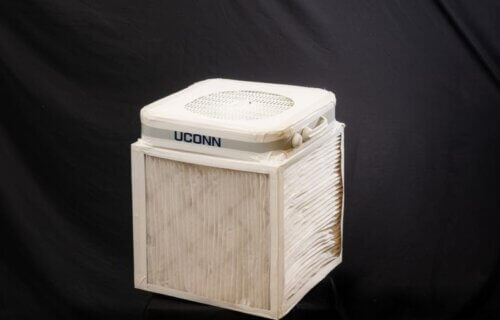STORRS, Conn. — If you want to avoid getting sick from the flu and other respiratory viruses this fall, the U.S. Environmental Protection Agency (EPA) has good news that will also save you money! They have tested a popular and low-cost “do-it-yourself” (DIY) air filter and found it was 99 percent effective in getting rid of airborne viruses.
The DIY filter is called the Corsi-Rosenthal box and you can make on in roughly 30 minutes with $60 worth of supplies from a hardware store. In the EPA’s testing of the DIY air filter, they found it helped in removing 97 percent of infectious aerosols in half an hour. This number improved to 99.4 percent when the air filter was in use for a full hour. Among the respiratory viruses officials tested, the homemade filter successfully removed a surrogate virus for SARS-CoV-2, the virus that causes COVID.
“These scientific results are huge!” explains Marina Creed, the director of the UConn Indoor Air Quality Initiative, in a university release. “These inexpensive, do-it-yourself air filters are for everyone. If you put this in your home, it will remove infectious germs that cause disease from the air. Schools, students, and teachers if you run one of these inside your classrooms it can reduce your exposure to viruses and bacteria, reducing the risk of disease transmission, meaning you are less likely to get sick.”

The DIY box came from University of Connecticut researchers who have been building and donating hundreds of air filters to the community, including the state’s public schools to reduce the risk of COVID transmission in classrooms.
The Corsi-Rosenthal box was tested three times in a bioaerosol chamber along with other air-cleaning technologies that emerged during the pandemic. The issue is that these other air cleaners are more expensive. The DIY filter reduced the amount of infectious virus in the air, regardless of size. It was capable of capturing small and larger-sized particles.
“CR boxes are more effective at reducing concentrations of infectious aerosols in indoor air than some of the more expensive technologies that we tested,” says Katherine Ratliff, a scientist for the EPA who led the testing.
In June, the inventors of the filter donated 150 free CR boxes to community members at risk from wildfire smoke particles in the air. They have also donated materials and STEM lesson plans for 100 air filters to schools in preparation for cold and flu season.
What do you need to build the filter?
According to the UConn researchers, it only takes four items to construct your own Corsi-Rosenthal box:
- Box fans: The team used Lasko or Utilitech brand 3-speed fans, costing roughly $20 – or you can use whatever box fan you have at home. Some other brands may be louder at low speeds than others; if used for instructional settings, these two models are about 51 decibels at low speed.
- MERV13 filters: Do not use a lower grade of filtration than MERV13, according to the researchers. Brands of filters used that work well include 2” thick from Texair, Filterbuy.com, and Pamlico, and 1” thick by 3M, Honeywell, and ACE Hardware.
- Duct tape: Not all duct tape is created equal! The team says they used 3M brand multipurpose and heavy-duty duct tape; Duct brand and ACE brand also work well. Avoid tapes that are made of “fabric” or “light duty use”.
- Cardboard: Save the cardboard from the fan box to make the bottom of the air purifier and the shroud on top. If using a box fan from home, find two 20-inch square pieces of cardboard.
PDF: How to build the Corsi-Rosenthal Box/Do-It-Yourself air purifier
For a video of step-by-step instructions on how to assemble the air filter, the UConn team created a 3-minute guide available here.
https://twitter.com/DavidElfstrom/status/1427792853636460544?ref_src=twsrc%5Etfw%7Ctwcamp%5Etweetembed%7Ctwterm%5E1427818905964265474%7Ctwgr%5E9db9ebc142604241d56685e8091fc8164dc95997%7Ctwcon%5Es2_&ref_url=https%3A%2F%2Fcleanaircrew.org%2Fbox-fan-filters%2F

I Love it. I’m making 1 for this old house ..